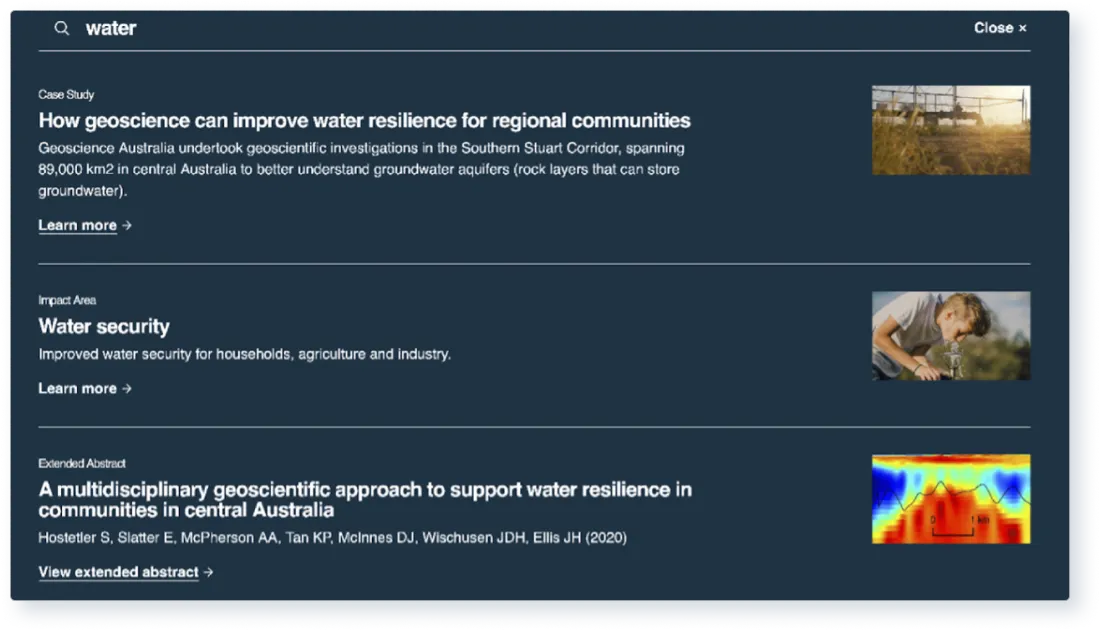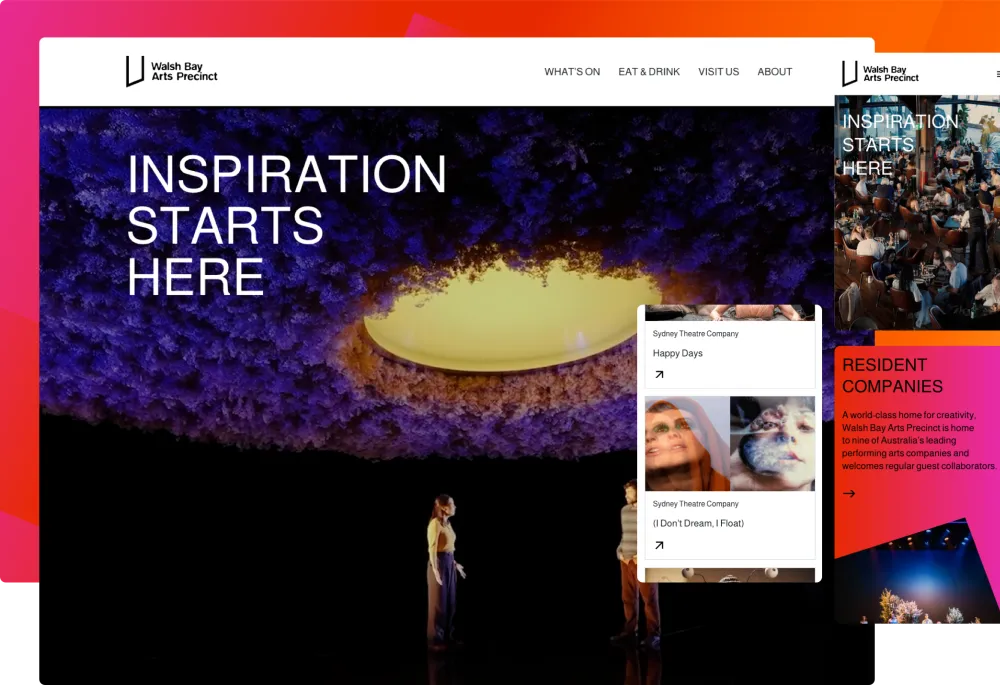Sector(s)
Project Team
Other organisations involved:
Team members:
- Con Fountas - Engagement Management
- Kristen Pol - Technical Lead
- Stuart Rowlands - Static Search SME
Visit the site
Visit the siteOrganizations Involved
Community contributions
Triage, review, feedback, and/or testing on various core and contributed project issues including:
Salsa Digital worked with Geoscience Australia and GovCMS to create an innovative search solution that can be used with a static copy of Geoscience Australia’s websites. This provides security via QuantCDN’s static services and a fully customisable search experience. Search metadata is captured in Drupal, pulled into the HTML header, then fed into Algolia using Quant configuration settings.
Geoscience Australia’s challenge
The new Geoscience Australia platform has been developed using static technologies via QuantCDN. Website visitors interact with a static output, which provides security, performance and scalability. However, we needed to create a search solution for the platform that would query the content in Quant rather than querying Drupal.
Back to topGeoscience Australia’s transformation — Algolia search
Salsa Digital created a flexible search solution that would work for all the Geoscience websites, including those with more complex search requirements like the Exploring for the Future website.
The DEA website has a global search that uses keywords. While it’s not obvious when you interact with the search, it’s actually using metadata that’s captured in Drupal and surfaced in the static content. The below screenshot shows some search results. The title, summary, type (e.g. news) and images are all metadata elements.
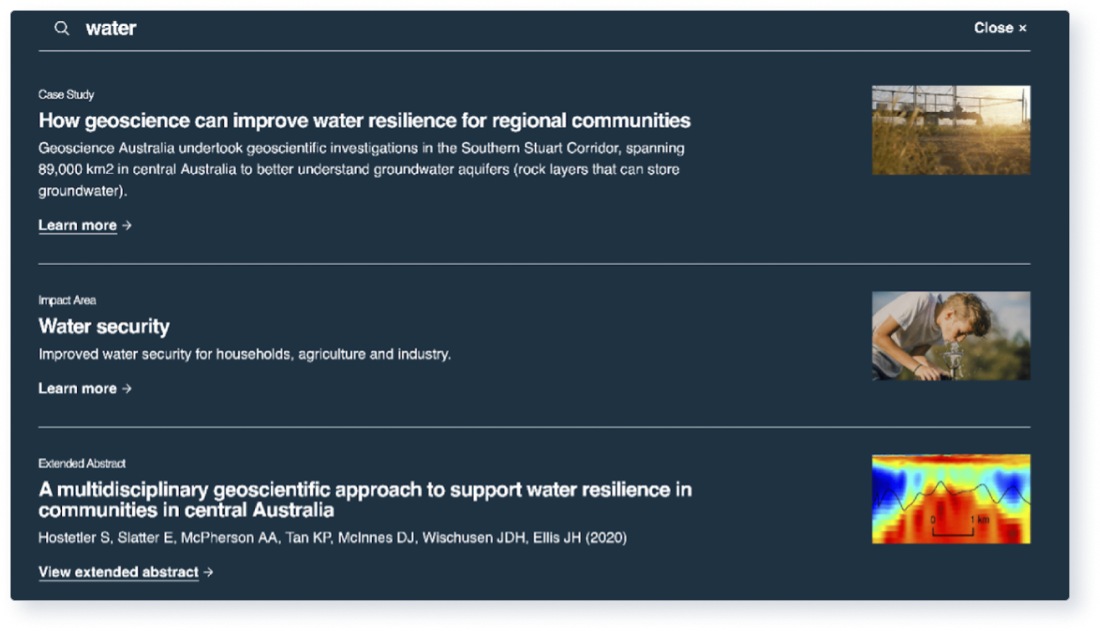
We needed to capture this metadata and feed it into Algolia. Salsa Digital’s solution is custom code in Nuxt.js, which pulls all the metadata from Drupal and puts that metadata into the header of the HTML. The code below shows an example of the HTML header.
<meta data-n-head="ssr" data-hid="search_date" name="search_date"
content="1631576651">
<meta data-n-head="ssr" data-hid="search_pretitle" name="search_pretitle"
content="Deep-dive projects">
<meta data-n-head="ssr" data-hid="search_title" name="search_title"
content="Darling–Curnamona–Delamerian">
<meta data-n-head="ssr" data-hid="search_summary" name="search_summary"
content="This project is delivering new data and knowledge to assess mineral
and groundwater potential and support water management across western
New South Wales and Victoria, eastern South Australia and northwest Tasmania.">
<meta data-n-head="ssr" data-hid="search_image" name="search_image"
content="/_nuxt/image/c8f2d7.jpeg">
<meta data-n-head="ssr" data-hid="search_url_text" name="search_url_text"
content="Learn more">
<meta data-n-head="ssr" data-hid="search_url_href" name="search_url_href"
content="/darling-curnamona-delamerian">
<meta data-n-head="ssr" data-hid="search_filter_content_tags"
name="search_filter_content_tags" content="EFTF - Current project">
<meta data-n-head="ssr" data-hid="search_filter_product_regions"
name="search_filter_product_regions" content="NSW">
<meta data-n-head="ssr" data-hid="search_filter_product_regions_1"
name="search_filter_product_regions" content="SA">
<meta data-n-head="ssr" data-hid="search_filter_product_regions_2"
name="search_filter_product_regions" content="TAS">
<meta data-n-head="ssr" data-hid="search_filter_product_regions_3"
name="search_filter_product_regions" content="VIC">
<meta data-n-head="ssr" data-hid="search_filter_product_systems"
name="search_filter_product_systems" content="Groundwater">
<meta data-n-head="ssr" data-hid="search_filter_product_systems_1"
name="search_filter_product_systems" content="Minerals">
<meta data-n-head="ssr" data-hid="search_filter_product_topics"
name="search_filter_product_topics" content="Basins">
<meta data-n-head="ssr" data-hid="search_filter_product_topics_1"
name="search_filter_product_topics" content="Lithospheric">
<meta data-n-head="ssr" data-hid="search_filter_product_topics_2"
name="search_filter_product_topics" content="Crust">
<meta data-n-head="ssr" data-hid="search_filter_product_topics_3"
name="search_filter_product_topics" content="Mantle">
<meta data-n-head="ssr" data-hid="search_filter_product_types"
name="search_filter_product_types" content="Current projects and activities">
<meta data-n-head="ssr" data-hid="search_filter_page_type"
name="search_filter_page_type" content="Project Detail">
The static content then gets pushed to QuantCDN. In Quant, we set up configurations that extract specific content and feed it into the Algolia search. The Quant ‘magic’ effectively maps it from Drupal metadata to Algolia search results. The screenshot below shows an example of the Quant mappings.
Back to topQuant mappings
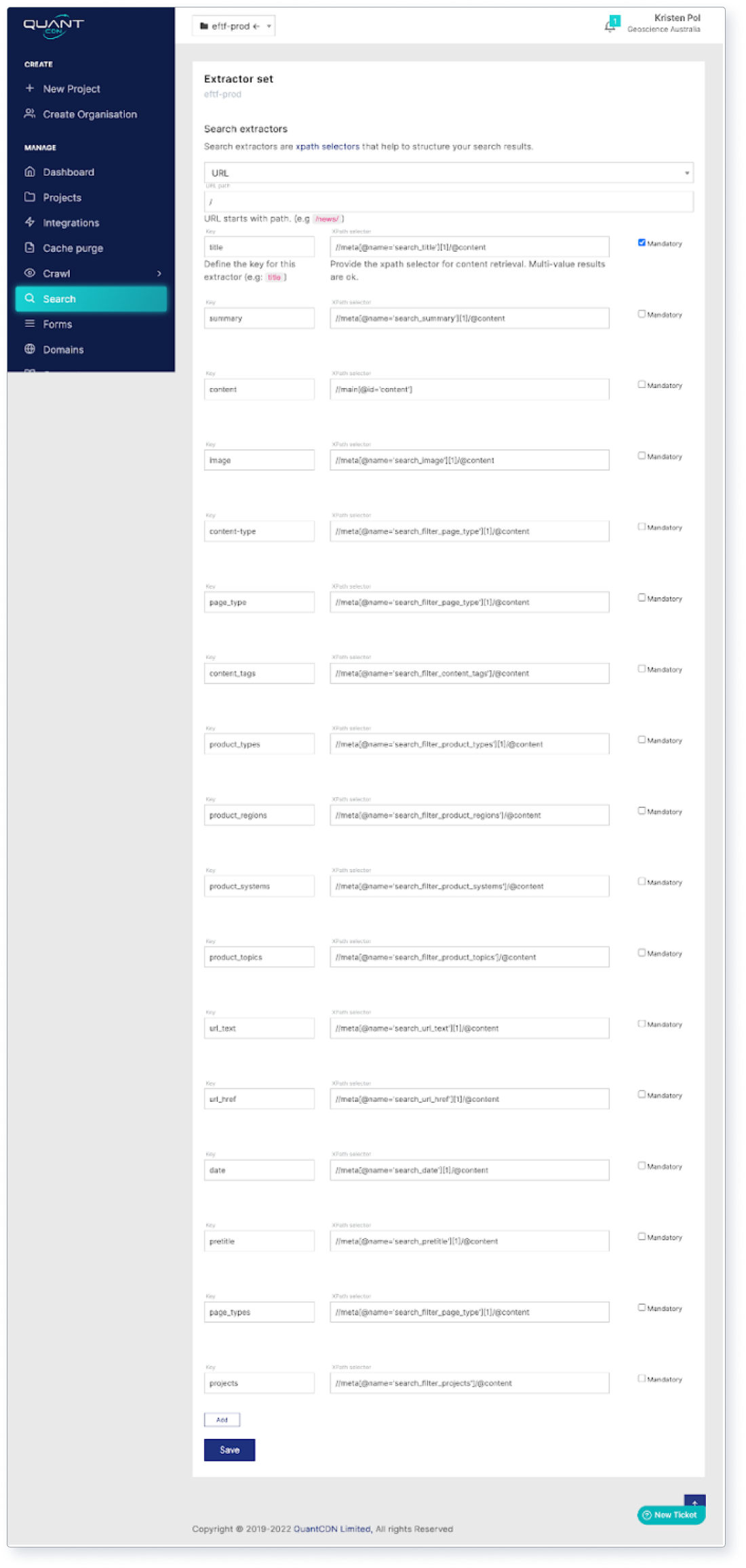
This also means we have full control over what’s shown in the search results. For example, we can show different summary information than what’s on the main page, different images, etc.
Back to topFaceted search
The next site we built on the new Geoscience Australia platform was the Exploring for the Future website. This website has a much more complicated search and includes faceted search (see example search page). Faceted search allows users to narrow down the results through filters.
When creating new pages with faceted searches, content authors can choose which facets/filters they’d like to show. This gives them complete control to create listing pages that are highly interactive.

The faceted search is also affected by the chosen keywords, so as you start typing a word the filters that no longer apply disappear so you can see the type of content that matches your keyword search. The screenshot below shows that when “multiscale” is entered as the keyword, only one project contains matching content. Likewise, there are two types of content with that keyword and one topic with that keyword.
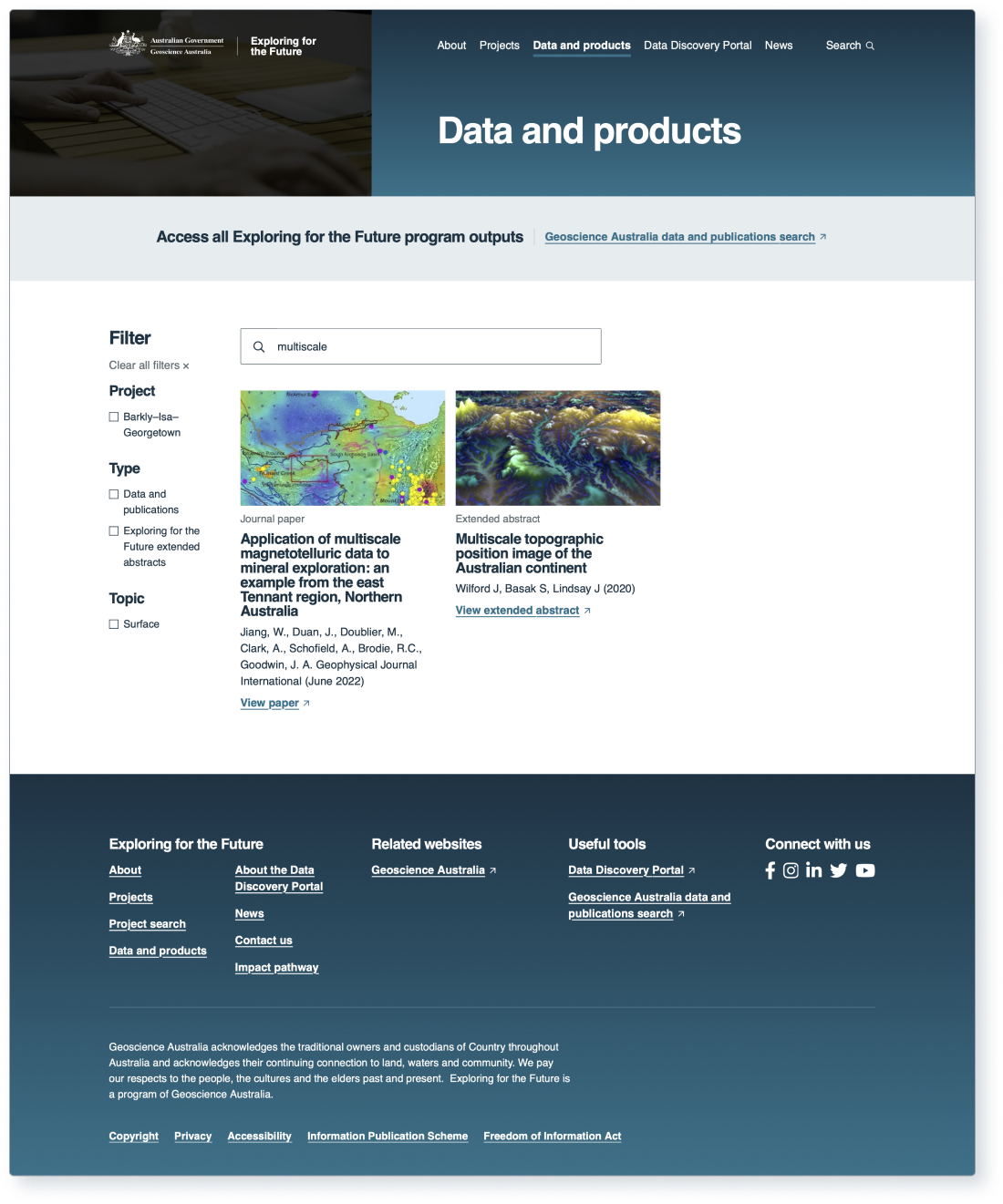
The outcomes — the benefits of static with customisable search
- A tailored search solution that can be used with static content and QuantCDN
- A more secure and faster search (because the search is querying Algolia and not the Drupal backend)
- A very flexible search that’s fully customisable by the content editors
- The ability to implement sitewide search
- The ability to implement very specific, faceted search (listing pages with keyword search and filters)
Drupal is the CMS of choice for the Federal Government in Australia, through the GovCMS platform. Salsa Digital recommended GovCMS for Geoscience Australia for three main reasons:
- GovCMS was looking to create a decoupled/headless capability within the platform, which aligned well with Salsa Digital’s technical recommendations
- GovCMS and Salsa Digital had also been discussing the next generation GovCMS being decoupled plus static Drupal and the static implementation would increase security and IRAP coverage (Australia’s cybersecurity assessment process) for Geoscience Australia
- This implementation would allow Geoscience Australia and GovCMS to lead the way in the Australian GovTech landscape

Technical Specifications
Drupal version:
Key modules/theme/distribution used:
GovCMS is a leading whole-of-government SaaS and PaaS Drupal hosting solution. The decoupled GA architecture allowed the site’s frontend to be developed independently from its backend using Vue.js, Nuxt.js and a design component library. The JSON:API and related decoupled modules were used to pull in the Drupal backend content into the frontend components. Paragraphs were used to create backend content components that easily map to the frontend components and are intuitive and flexible for the content admins.
